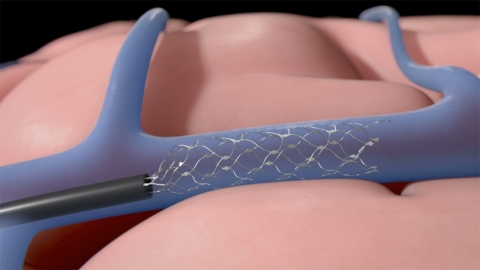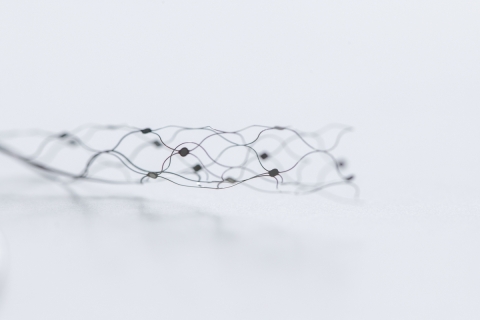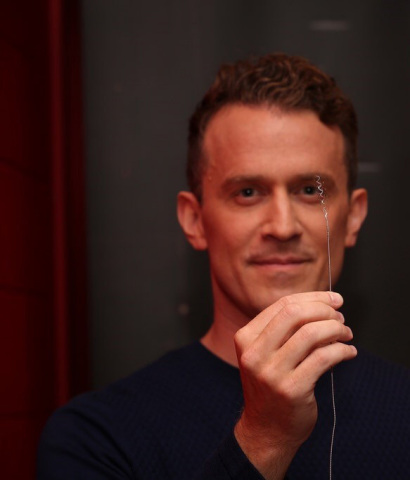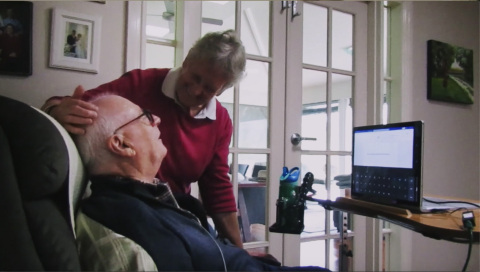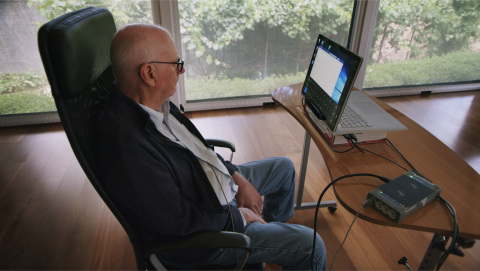SAN FRANCISCO & NEW YORK CITY & MELBOURNE--(BUSINESS WIRE)--Synchron, a neurovascular bioelectronics medicine company, today announced publication of a first-in-human study demonstrating successful use of the Stentrode™ brain-computer interface (BCI), or neuroprosthesis. Specifically, the study shows the Stentrode’s ability to enable patients with severe paralysis to resume daily tasks, including texting, emailing, shopping and banking online, through direct thought, and without the need for open brain surgery. The study is the first to demonstrate that a BCI implanted via the patient’s blood vessels is able to restore the transmission of brain impulses out of the body, and did so wirelessly. The patients were able to use their impulses to control digital devices without the need for a touchscreen, mouse, keyboard or voice activation technology. This feasibility study was published in the Journal of NeuroInterventional Surgery (JNIS), the leading international peer-review journal for the clinical field of neurointerventional surgery, and official journal of the Society of NeuroInterventional Surgery (SNIS).
“This is a breakthrough moment for the field of brain-computer interfaces. We are excited to report that we have delivered a fully implantable, take home, wireless technology that does not require open brain surgery, which functions to restore freedoms for people with severe disability,” said Thomas Oxley MD PhD, founding CEO, Synchron. “Seeing these first heroic patients resume important daily tasks that had become impossible, such as using personal devices to connect with loved ones, confirms our belief that the Stentrode will one day be able to help millions of people with paralysis.”
The patients enrolled in the study utilized the Stentrode neuroprosthesis to control the Microsoft Windows 10 operating system, in combination with an eye-tracker for cursor navigation, without the need for a mouse or keyboard. The subjects undertook machine learning-assisted training to control multiple mouse click actions, including zoom and left click. The first two patients achieved an average click accuracy of 92% and 93%, respectively, and typing speeds of 14 and 20 characters per minute with predictive text disabled. The patients used the neuroprosthesis to resume daily tasks independently, including text messaging, online shopping and managing finances. Following implantation and training, patients commenced unsupervised home use of the system from day 86 and day 71, respectively.
“Using the Stentrode has been life-altering,” said Graham Felstead, the first patient enrolled in the first Stentrode clinical study and the first person to have any BCI implanted via the blood vessels. “The device has allowed me to be productive again, including shopping, banking, and delegating tasks among the Rotary Club members with whom I volunteer. It’s incredible to gain this level of independence back.” By using the Stentrode, Graham was able to achieve his goals of remotely contacting his spouse, increasing his autonomy and reducing her burden of care. He was able to maintain contact with other family members, medical professionals and people in his community. Graham, a 75-year-old man living at home with his wife, has experienced severe paralysis due to amyotrophic lateral sclerosis (ALS), and received the Stentrode implant in August 2019. He continues to use it today.
“It is truly amazing, and very rewarding, to see the participants use the Stentrode to control a computer with their minds, independently and at home,” said Nicholas Opie, associate professor and co-head of the vascular bionics laboratory at the University of Melbourne and founding CTO of Synchron. “The trial participants have been fantastic, and my colleagues and I are truly honored to make a difference in their lives. I hope others are inspired by their success.”
The second participant, Philip O’Keefe, a 60-year-old man with ALS, working part time and living at home with his wife and two children, was able to control computer devices to conduct work-related tasks and other independent activities after receiving the Stentrode in April 2020. Functional impairment to his fingers, elbows, and shoulders had previously inhibited his ability to engage in these efforts.
“While the Stentrode is a completely novel concept and design, the procedure to implant it draws upon techniques that I use on a daily basis and which have become routine in our industry. The Stentrode technology exemplifies the progress and potential of neurointervention departments to deliver new therapies to patients,” said Professor Peter Mitchell, Director of Neurointervention, The Royal Melbourne Hospital, a pioneering neurointerventionalist who performed the first clinical implantations of the Stentrode device. “The intricacies of the brain have always fascinated me and enabling a patient with paralysis to continue to use their mind in a productive way is immensely rewarding.”
As the Stentrode device is small and flexible enough to safely pass through curving blood vessels, the implantation procedure is similar to that of a pacemaker and does not require open brain surgery. Neurointerventional surgery has rapidly grown as a subspecialty over the last 20 years and is now the first line option for cerebral aneurysm and large vessel stroke treatment. Entry through the blood vessels may reduce risk of brain tissue inflammation and rejection of the device, which has been an issue for techniques that require direct brain penetration. Implantation is conducted using well-established neurointerventional techniques which do not require any novel automated robotic assistance.
“Other approaches to brain-computer interfaces have been focused on high data rates, which create technical barriers to clinical translation. Synchron has focused on building a product that measurably improves patients’ lives. Our first-to-market product will focus on smart device control using brain impulses, without the need for the use of the hands. This alone has potential to address an unmet market need in 30 million patients in advanced economies,” added Oxley.
Stentrode has been granted Breakthrough Device designation from the U.S. Food and Drug Administration (FDA), a status reserved for innovative solutions addressing irreversibly debilitating conditions. The safety and efficacy data from this feasibility study will be used to finalize protocols for a future FDA-approved trial that will guide evaluation for U.S. marketing approval.
Preliminary data on the first patient were initially presented at the Society of NeuroInterventional Surgery (SNIS) 17th Annual Meeting on August 7, 2020. Stentrode's long-term safety as well as its ability to pick up specific electrical frequencies emitted by the brain was established by pre-clinical studies published in top ranking journals including Nature Biotechnology, Nature Biomedical Engineering and the Journal of Neurosurgery.
The initial indication for brain-computer interfaces for people with severe paralysis to restore independent activities of daily living (IADL) has the potential to be a $2 billion industry. Future indications, currently being explored by Synchron, will expand the brain-computer interface market.
Citation: Oxley TJ, et al. J NeuroIntervent Surg 2020;0:1–7. doi:10.1136/neurintsurg-2020-016862.
About Stentrode™
The only interventional neural interface platform, the Stentrode™ is designed to function as both a neuroprosthesis and neuromodulation device. In the first clinical trial, the tiny Stentrode motor neuroprosthesis is implanted next to the brain’s motor cortex using procedures commonly used for neurovascular stent implantation, without open brain surgery. In addition to the implant, the Stentrode, a brain-computer interface, relies on a fully-internalized, wireless solution implanted in the chest that provides high-resolution neural data transmission; and a revolutionary brain-controlled hands-free app platform that translates brain impulses into a standardized digital language. The Stentrode is undergoing clinical investigation to evaluate its ability to improve functional independence for people with paralysis by restoring command control of external devices that facilitate instrumental activities of daily living, such as text messaging. Future interventional neuromodulation applications may include the potential to diagnose and treat nervous system conditions from within blood vessels, including Parkinson’s disease, epilepsy, depression, and hypertension.
About Synchron, Inc.
Synchron, Inc. is a neurovascular bioelectronics medicine company developing bloodstream-enabled solutions for previously-untreatable nervous system conditions. The company is pioneering the field of interventional neuromodulation and developing the world’s first motor neuroprosthesis, the Stentrode™, a brain-computer interface in clinical trials to evaluate its ability to help paralyzed patients regain the ability to regain functional independence. The company is also developing endovascular neuromodulation solutions for the potential treatment of Parkinson’s disease, epilepsy, depression and hypertension, among other disorders. Development of this technology platform was spun out of the University of Melbourne and has been funded in part through grants from the U.S. Defense Advanced Research Projects Agency (DARPA) and U.S. Department of Defense (DoD). The technology was publicly endorsed by then-President Barack Obama as “technology that has the potential to transform lives of our wounded warriors and those with disability.” Neuro Technology Investors, LLC, subsequently led the Series A round of financing, which also included METIS innovative. Headquartered in Silicon Valley, California, Synchron has a presence at Newlab in Brooklyn, New York and R&D facilities in Melbourne, Australia.


